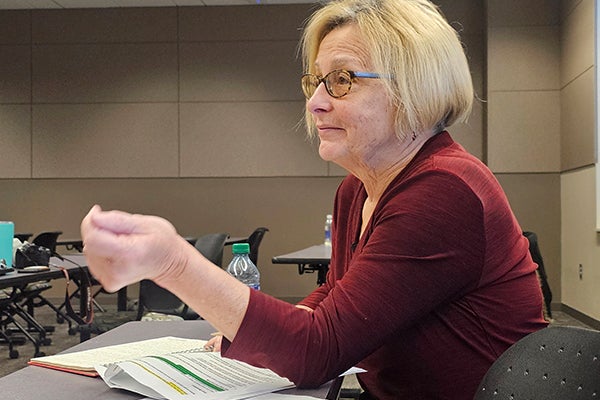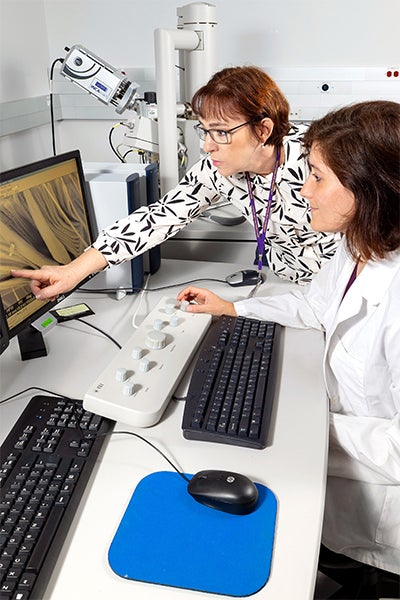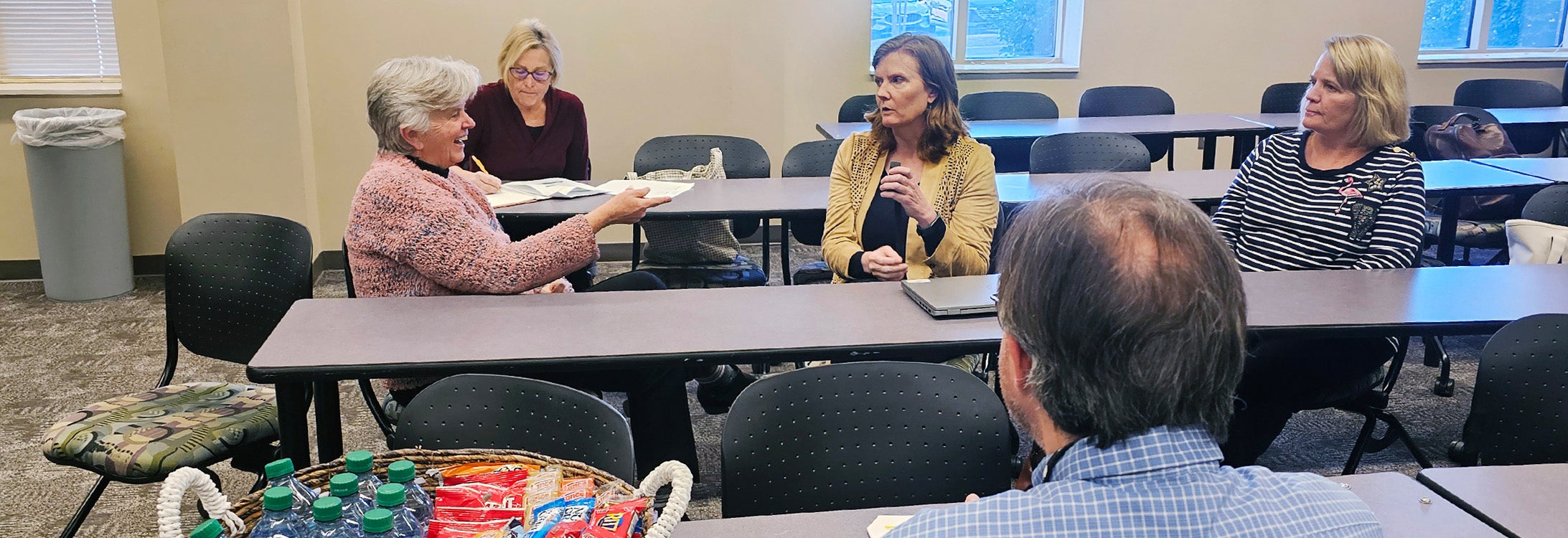ECU academic community studies AI integration into university operations
East Carolina University has embarked on a groundbreaking study to determine how institutions of higher education can incorporate artificial intelligence into teaching, research and administrative activities to keep pace with the blisteringly fast advances in machine learning.
During the two-year Making Artificial Intelligence Generative for Higher Education (MAIGHE) research project, a team led by Jan Lewis, ECU’s director of academic library services, will interview faculty, students and other stakeholders about how they are integrating AI into their academic and research work.
ECU is joined by 19 other universities, including Princeton University, Yale University, Temple University and Carnegie Mellon University — and Duke University as the only other North Carolina institution — in creating the nation’s “largest qualitative dataset to date on AI issues and opportunities related to teaching, learning and research in higher education.”
“As Ithaka’s work is published, we’ll see that ECU will be featured prominently in terms of the work that is being done here, the intervention that is used and the way we are part of this collaboration to help move the needle on the integration of generative AI tools in higher education,” Lewis said.
Integrating AI into teaching and administration

Zach Loch, ECU chief information officer
In February, Zach Loch, ECU’s chief information officer, sent an internal email with guidelines for using artificial intelligence at ECU. In short, he offered two pieces of advice: use public information, not proprietary institutional data; and if using institutional data, the university’s information security experts need to analyze the AI tools used to process that information.
“I’m really proud to say that East Carolina University is one of the first to create some guidelines,” Loch said. “What the policy does is lay out clear guidelines on how AI should be used with institutional data, and I think we’re leading that effort.”
Loch said that up until a few years ago, many people’s only understanding of AI was from watching IBM’s AI-powered Watson system dominate a Jeopardy game show or beat chess masters. ChatGPT, one of the first publicly accessible AI tools, took hold of the public consciousness in 2022 and became something of a party trick.
“You could ask it to write songs, tell jokes, craft contractual language. There are a host of things that it can do,” Loch said.
But Loch said the possible applications for how to make AI useful in everyday life are just becoming apparent, from administrative services and patient care, to how students and teachers share learning experiences in and out of the classroom.
While the challenges for how to implement AI in the classroom are numerous, and probably not yet fully conceptualized, Loch said one unique aspect of the implementation is that everyone — students and teachers alike — are learning how to grapple with the technology at the same time.
Loch acknowledges that students are likely using AI to assist with assignments. He also knows that teachers are dedicating effort to decide what rules should be included in syllabi to govern the use of AI in the classroom. They are also working to determine how to use AI to “create course content, new test questions” and keep course content fresh and up to date.
Research, Loch said, is an important part of the university’s mission, and ECU researchers are diving headlong into creating AI tools that can crunch numbers on large data sets and answer research questions in ways that have, as of yet, been too resource intensive.
Loch sees it as his responsibility to lead the university’s integration of AI into classrooms and research settings.
“We owe it to our students to help them navigate this world and understand what these tools can do … and how to best use these tools when they get to the real world, because the truth is they’re going to be using them,” Loch said.
Loch believes AI tools will be incredibly useful for education but cautions that students will need to understand underlying concepts to be able to leverage the benefits of AI.
“Students still have to be grounded on the basics, but then understand how these tools can help them,” Loch said.

Jan Lewis leads a discussion of the incorporation of AI into ECU academic programs at the College of Nursing.
How faculty and students are using AI
ECU’s research team has heard from some faculty who think it would be beneficial to learn more about AI from someone in their discipline. ECU’s cohort discussions began with the Department of English and have branched out as the project has progressed.
“There are probably faculty at every stage — skeptics, cautious, curious, champions — in every discipline,” Lewis said. “A few of the people I interviewed are early adopters and innovators, and they may not be representative of everyone in that college or that discipline.”
Dr. Mary Jo Nimmo, a clinical assistant professor of nursing, started her career in the 1980s as a flight nurse with ECU Health’s predecessor. When she went back to school for her master’s degree and had to write a paper as part of a final exam, she asked her professors if she could use a then-cutting-edge computer to type her submission.
“I had a knack for using computers, and in 1991, when computers were hitting the workforce, I was hired at Lenoir Memorial in Kinston as the director of support services,” Nimmo said. “We got nursing assistants to put vital signs into a computer and print them out for the doctors and that was the most amazing thing that the physicians had ever seen.”
The hospital soon promoted her to be the IT director and for 12 years she watched the progression from doctors and nurses considering computers to be ‘evil’ to the point that health systems are “using data and making differences in patients care.”
In one of Nimmo’s spring classes, she tasked her masters nursing students with an experiment: one student used an AI-powered search tool to research health systems across the world, and the balance of her students evaluated the quality of the information returned by the AI system.
“Just because you put something into AI doesn’t mean it’s absolutely correct; you have to validate it,” Nimmo said.
Similar findings have occurred in the ECU Department of Coastal Studies. Students regularly use machine learning, a subset of AI with a predictive element, in dissertation research and satellite image processing. Graduate research assistant John Sabin uses machine learning, but he said it requires balancing and review.
“It opens up avenues, but it’s just like spell check in that you don’t really think of what it’s doing,” Sabin said. “That’s a really low-level machine learning tool and it’s going to change a word, but does it change the whole idea? Staying on top of the research is tricky, which is why these things take multiple layers of validation and then connecting it back to the purpose.”
Sabin defended his dissertation March 25, noting how AI can help in predictability and decision-making related to his research that focused on the Florida Everglades.
“It’s like when the internet first became a big thing. This is kind of like another big revolution, which is exciting and hopefully for best practices,” Sabin said.
Faculty need to understand how to use AI
After the attacks of Sept. 11, Nimmo was asked to use her computer skills to aid a statewide epidemiology group tasked with early identification of possible biological warfare outbreaks. Due to an application of early machine learning tools, the epidemiology team identified a food poisoning outbreak in Chapel Hill within hours, a task that would have taken days without the use of computer technologies that sifted through mountains of information.
Nimmo believes that one of the difficulties faculty face is learning themselves how to use generative AI. Fear of potential pitfalls runs the risk of derailing experiential learning that can put students in the best position to employ AI in the boardroom and at the hospital bedside.
“I think our challenge is how fast AI is going. You hear from everybody about the fear of cheating. ‘Oh, my gosh, the student is going to use it and cheat.’ Well, that’s the same student who would cheat anyway,” Nimmo said.
Challenges could also differ across disciplines.
“I think we all just have to make the effort to stay up with what’s going on in defined areas,” Lewis said. “For me, it’s what’s going on in librarianship and in broader higher education, so I can support that as a library director. Also, I’m extremely interested in the efficiencies generative AI can offer for anybody who uses email, writes and proofs documents, has numerous meetings or manages a complicated schedule. How can AI help us accomplish those tasks and free up more time for higher level responsibilities?”
Nimmo added that professors need to think broadly about how AI can be used by students to broaden their post-graduation employment skills.
“My next assignment is a business plan. If my students are in the real world and had to develop a business plan and knew about AI, the first thing they would do is ask AI the best way to attack this business plan,” Nimmo said. “Why not teach that? I think in education, there is a lot of fear.”
Nimmo has a lot of sympathy for her fellow faculty members across ECU’s campuses because AI is advancing at a rate that makes it nearly impossible to keep pace.
“My goal is to stay in the present, to learn as much as I can, but also teach my peers on how to use it,” Nimmo said.
How will ECU alumni use AI after graduation?

ECU researchers study medical imagery, a task that holds promise to be made quicker and more precise through the use of artificial intelligence.
Lewis pointed out that when faculty have asked students to use generative tools in their class, there have been positive outcomes. A hope is when used correctly, AI could play a role in students gaining relevant experience and skills.
“Hopefully it will give these students a leg up in the job market, because that is something else we hear all the time is that job postings will include a generative AI or artificial intelligence tool literacy or knowledge component in it,” Lewis said. “I think it’s really important we think about how students can develop those competencies for the workplace.”
Much of the recent integration of AI into health care has centered on the physician, Nimmo said, which she said is important, but the health care team members who could benefit from AI extend from clinics to hospitals and beyond.
“Nurses say that collecting data is very difficult for them; it takes their time and it’s very hard. When we first started with electronic health records, the flow sheets were manageable, but then we asked for more data and more data, and we never seem to get rid of the stuff we don’t use,” Nimmo said.
One of the cutting-edge applications of AI in hospitals in North Carolina allows nurses to use speech-to-text to populate a patient’s charts. Once the routine health metrics — like heart rate, oxygen and blood sugar levels — are spoken into the system, the nurse only needs to double check the chart, saving time and effort for members of the patient care team who are already overburdened, Nimmo said.
She hopes to be able to transition successful implementation of the technology from the hospital to the classroom to prepare Pirate nurses to use emerging AI-integrated technologies the first day on the job after graduation.
“I can envision the difference AI is going to make in patient care,” Nimmo said. “The amount of data we have now, one person having to go out and search all of the databases then derive an answer from that, it’s impossible. But having AI do that, now I can see the difference that will make in patient care. I’m excited about it.”
